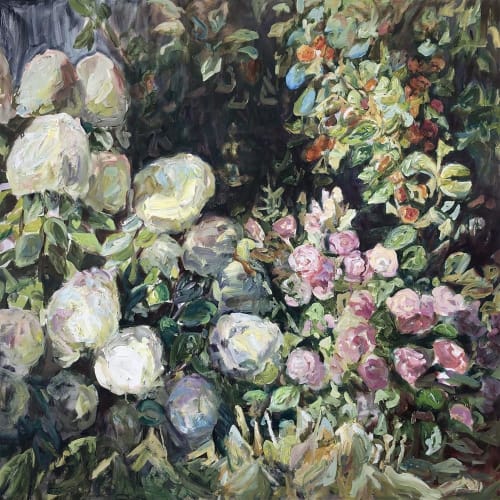Flowers Reigning Supreme
Watercolourist Madeleine Lemaire (1848-1928) who illustrated Marcel Proust’s Pleasures of Days in 1896 was known in Paris as the Empress of Roses. A feast for the eyes, her blowsy flowers, tumbling forth from vases and urns, appeal to other senses as well. You can imagine them scenting the pages with a heavy perfume or whispering the secrets of languorous summer days.
So it is with Katherine Throne’s luscious oil paintings of flowers, created in the Central Otago town of Wanaka which has been her home since 2020. Once she located her blooms at home in their beds in suburban Grey Lynn; now she is drawn to the hardy wild flowers of Central. Depicting garden escapes like rogue lupins and insouciant daisies, which thrive in the extreme temperatures and stony soils, reminds her of her two daughters, growing up strong and free. Such is the enduring appeal of floral art, that viewers are seduced by details such as the curl of a petal, as well as succumbing to the heady effect of a profusion of blooms, but there are tender maternal feelings invested here as well.
Throne’s sense of humour, evident in her titling, undercuts any sobriety of tone, and plays off against the old meanings given to the flowers depicted. Orange zinnias, clamouring for attention are Ringleaders, rather than symbolising the circle of life, ambition, fertility, and abundance. The full-face innocence of white oxeye daisies open to the midday sun constitutes an Illicit Gathering, not a manifestation of purity. In this way, she imbues her flower portraits with cheeky sass and individuality, competing for our affections. Viewed at close range, each of these garden varietals is caught in the act of asserting its claim for supremacy in the herbaceous border.
Clearly these are modern flowers, not bound by the traditional expectations set up by the centuries-old language of flowers. Similarly, Throne’s daughters will not grow up as shrinking violets, but will bloom into their independence in time. Yet the fourteen paintings in Rebels and Romantics still evoke the metaphorical power of flowers to represent the concept of beauty, and the pleasure to be found in nature in an ordinary back garden. Throne’s skill in manipulating paint to simulate the patterns of light falling on floral abundance fills us with delight. Each work is a portrait of strength, courage and endurance, qualities we can all admire and aspire to.
An essay by Dr. Linda Tyler

